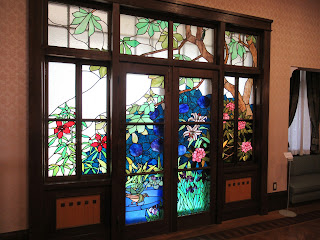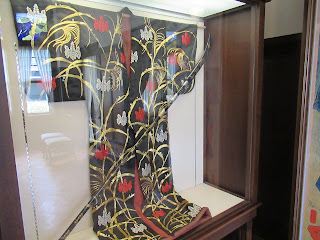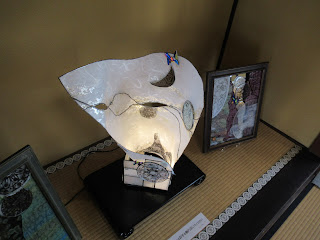The second place I visited in Nagoya was Futaba Museum. It is a house where Japan’s first actress Sadayakko Kawakami lived with Momosuke Fukuzawa, who was the director of Nagoya Dento (Nagoya Electricity) and called the king of electrical power, during the Taisho period (1912-1926). I walked there from Tokugawa Art Museum. It was located in a quiet residential area between the art museum and Nagoya Castle. It was an eye-catching house among plain modern buildings in the area.
This museum was one of the admission-free sightseeing spots on October 20. I visited there partly because I like to see stained glass. In the entrance hall, there were big beautiful pieces that welcomed visitors.
When I looked this one, I remembered that Sadayakko herself used to dance and play musical instruments. She was a famous geisha in Tokyo before she married Otojiro Kawakami. With her husband, she toured around the U.S. and Europe and performed brilliantly as an actress.
This is her poster (replica) by a Swiss Painter Alfred Muller for the 1900 Paris Exhibition. She was praised by Rodin, and Picasso painted her performing on the stage.
This kimono is her only stage costume that remains today. It was very big. There was also a replica of a halberd. It is called naginata in Japanese and was often used by women during the Warring States period. I imagined how powerfully she had performed on the stage with this long weapon in her hands.
Sadayakko retired from acting after her husband Otojiro died in 1911. She started to live in this house with her first love, Momosuke Fukuzawa; they met for the first time around 1885 when they were teenagers. Futaba Museum has many tatami rooms with Sadayakko’s belongings displayed. I think she had good taste. For example, I had never seen a hibachi (appliance to warm up the room with charcoal) like this.
This is her shamisen, a musical instrument she used to play.
On the black suitcase, there are initials “M.F.” The brown case on the right has a label “HOTEL (?) CONTINENTAL PARIS.” Maybe it had traveled around Europe with Sadayakko.
These are Sadayakko’s writing desk and cushion.
In the museum, they had also an exhibition of stained glass. This one was displayed on the first floor. The combination with Chinese characters was interesting.
The stairs to the second floor were beautiful.
There were more pieces of stained glass on the second floor. I learned that you can used stained glass in many ways.
This one was used for the poster of this exhibition. It was fantastic.
I liked this combination very much. Like Futaba Museum itself, it was a wonderful combination of Western and Japanese cultures.
This time, I walked to the museum from Tokugawaen. But you can take the Nagoya Sightseeing Route Bus “Me-guru”, which may be the easiest way to get there. The website “NAGOYA-INFO” provides various information for tourists.
Introduction of Delicious Food, Restaurants, and Sightseeing Spots
Subscribe to:
Post Comments (Atom)
Happy New Year of Ox 2021
If you are in Japan during the year-end and New Year holidays, you can see many pretty sweets at Japanese confectionary stores. As 2021 is t...

-
Several months ago, I read about vegan noodle “Shin Ramen (Shin Ramyeon/Shin Ramyun)” made by a food company Nongshim in Korea on the Intern...
-
Saizeriya is a popular Italian restaurant chain. It has more than 1,000 restaurants all over Japan, including 6 restaurants in Hamamatsu. On...
-
Tianjin sweet roasted chestnuts (天津甘栗 (tenshin-amaguri)) or sweet chestnuts (甘栗(amaguri)) are one of popular snacks in Japan. They are avail...

















No comments:
Post a Comment